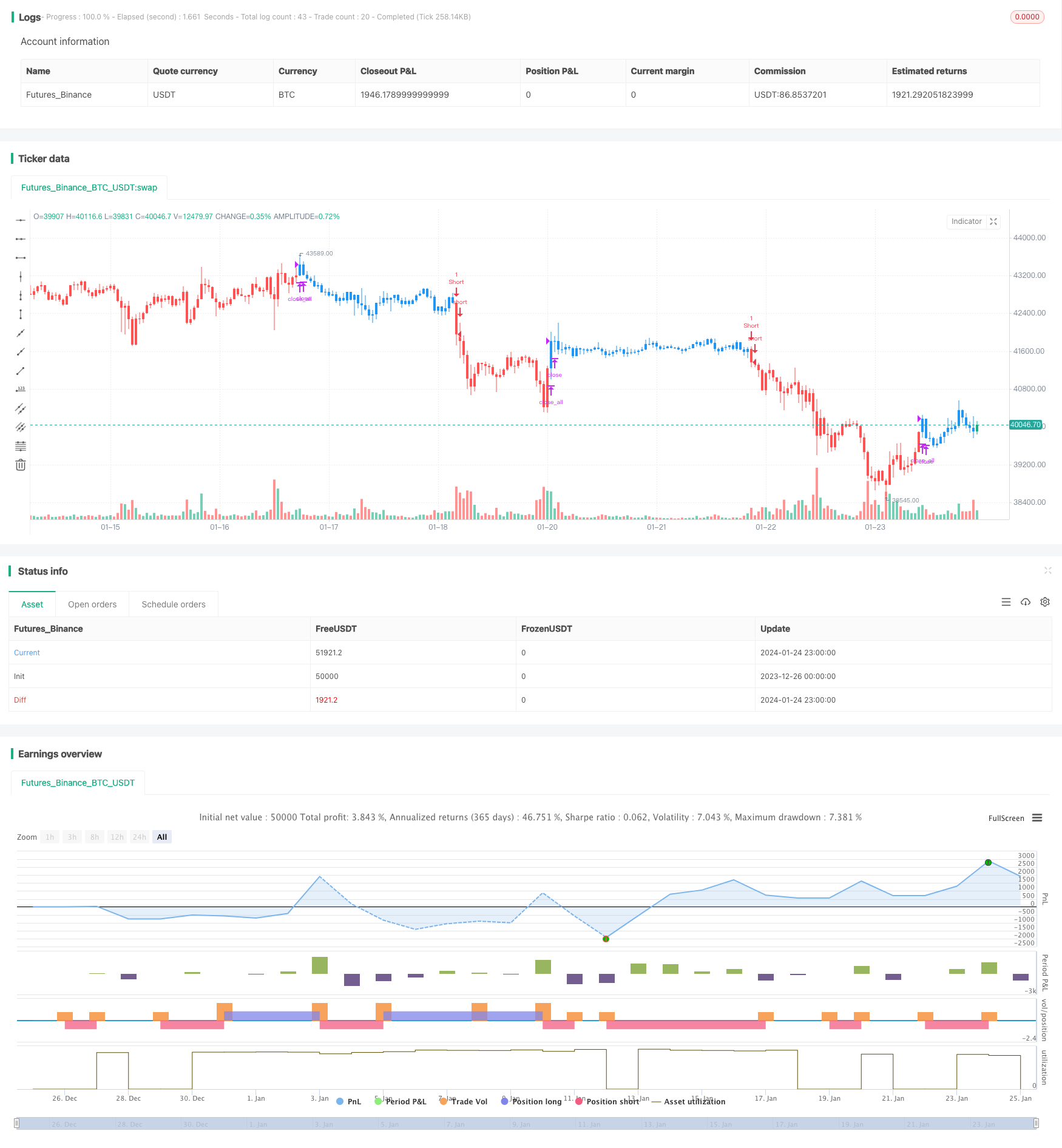
概述
双均线反转与ATR trailing stop组合策略是一个非常实用的量化交易策略。该策略首先利用双均线形成的死叉和Golden交叉来判断市场趋势和反转点。同时,策略还会结合平均真实波幅来设置trail stop,在保证获利的同时控制风险。
策略原理
双均线反转策略
双均线反转策略利用快线和慢线的交叉来判断市场趋势。当快线从上向下穿过慢线时,形成死叉,表示市场由涨转为跌;当快线从下向上穿过慢线时,形成Golden交叉,表示市场由跌转为涨。策略在死叉时做空,在Golden交叉时做多。
具体来说,策略选用9日STOCH指标的快线作为快线,3日EMA作为慢线。当close低于前一日close,且快线高于50而上穿慢线时清仓做空;当close高于前一日close,且快线低于50而下穿慢线时清仓做多。
ATR Trailing Stop策略
ATR Trailing Stop策略利用平均真实波幅来设置止损点。ATR指标可以有效反映市场的短期波动性。策略根据ATR的值来设置trail stop,当价格走势反转时止损退出。
具体来说,策略选用5日ATR,止损点设为close减去ATR的3.5倍。当价格达到该止损点时平仓止损。
优势分析
双均线反转与ATR trailing stop组合策略结合了均线策略判断趋势和反转的优势,以及ATR trail stop策略控制风险的优势,使其成为一个非常实用的策略。
具体来说,该策略有以下优势:
利用双均线形成的死叉和Golden交叉来判断市场趋势转折点,精准判断反转信号。
结合STOCH指标来确认反转信号,避免错误信号。
ATR trailing stop根据市场波动灵活设置止损点,最大程度锁定利润。
该策略融合了多种指标和技术分析方法,进行组合使用,使策略更加稳健。
策略思路清晰易理解,参数调整灵活,容易实盘操作。
风险分析
虽然该策略有许多优势,但也存在一定的风险需要注意:
双均线生成的信号可能存在滞后,无法在反转点前后准确买入和卖出。可以适当缩短均线周期或结合其他指标进行优化。
ATR指标对市场大幅波动不敏感,无法及时更新止损点。可以考虑结合动量指标或波动率指标进行调整。
多种参数和条件的组合使用增加了策略复杂度。参数不当可能造成过于激进的交易而增加风险。需谨慎评估并逐步调整参数。
优化方向
根据上述风险分析,该策略可以从以下几个方面进行优化:
调整均线周期参数,缩短周期以提前捕捉反转机会。
添加其他指标判断反转信号,如MACD,KD等,形成多重确认。
动态调整ATR周期或引入市场波动率,实时更新止损点。
评估股票和期货市场的差异,分别调整参数,使之更符合两种市场的特点。
在回测时加入交易成本和滑点的考量,使策略更加接近实盘交易环境。
可以考虑加入机器学习模型来动态优化多个参数。
总结
双均线反转与ATR trailing stop组合策略是一个高效实用的量化策略。它融合了均线判断市场反转和ATR setting trail stop控制风险的双重优势。在确保获利的同时可以减少不必要的损失。该策略参数调整灵活,易于实盘操作。同时也可以从多个角度进行扩展与优化,使其适用于更广泛的市场环境。总体来说,该策略为量化交易提供了一个非常出色的策略框架。
/*backtest
start: 2023-12-26 00:00:00
end: 2024-01-25 00:00:00
period: 1h
basePeriod: 15m
exchanges: [{"eid":"Futures_Binance","currency":"BTC_USDT"}]
*/
//@version=3
////////////////////////////////////////////////////////////
// Copyright by HPotter v1.0 17/05/2019
// This is combo strategies for get
// a cumulative signal. Result signal will return 1 if two strategies
// is long, -1 if all strategies is short and 0 if signals of strategies is not equal.
//
// First strategy
// This System was created from the Book "How I Tripled My Money In The
// Futures Market" by Ulf Jensen, Page 183. This is reverse type of strategies.
// The strategy buys at market, if close price is higher than the previous close
// during 2 days and the meaning of 9-days Stochastic Slow Oscillator is lower than 50.
// The strategy sells at market, if close price is lower than the previous close price
// during 2 days and the meaning of 9-days Stochastic Fast Oscillator is higher than 50.
//
// Secon strategy
// Average True Range Trailing Stops Strategy, by Sylvain Vervoort
// The related article is copyrighted material from Stocks & Commodities Jun 2009
//
// WARNING:
// - For purpose educate only
// - This script to change bars colors.
////////////////////////////////////////////////////////////
Reversal123(Length, KSmoothing, DLength, Level) =>
vFast = sma(stoch(close, high, low, Length), KSmoothing)
vSlow = sma(vFast, DLength)
pos = 0.0
pos := iff(close[2] < close[1] and close > close[1] and vFast < vSlow and vFast > Level, 1,
iff(close[2] > close[1] and close < close[1] and vFast > vSlow and vFast < Level, -1, nz(pos[1], 0)))
pos
ATR_TrailingStop(nATRPeriod, nATRMultip) =>
xATR = atr(nATRPeriod)
nLoss = nATRMultip * xATR
pos = 0.0
xATRTrailingStop = 0.0
xATRTrailingStop := iff(close > nz(xATRTrailingStop[1], 0) and close[1] > nz(xATRTrailingStop[1], 0), max(nz(xATRTrailingStop[1]), close - nLoss),
iff(close < nz(xATRTrailingStop[1], 0) and close[1] < nz(xATRTrailingStop[1], 0), min(nz(xATRTrailingStop[1]), close + nLoss),
iff(close > nz(xATRTrailingStop[1], 0), close - nLoss, close + nLoss)))
pos := iff(close[1] < nz(xATRTrailingStop[1], 0) and close > nz(xATRTrailingStop[1], 0), 1,
iff(close[1] > nz(xATRTrailingStop[1], 0) and close < nz(xATRTrailingStop[1], 0), -1, nz(pos[1], 0)))
pos
strategy(title="Combo Backtest 123 Reversal & Average True Range Trailing Stops", shorttitle="Combo", overlay = true)
Length = input(14, minval=1)
KSmoothing = input(1, minval=1)
DLength = input(3, minval=1)
Level = input(50, minval=1)
nATRPeriod = input(5)
nATRMultip = input(3.5)
reverse = input(false, title="Trade reverse")
posReversal123 = Reversal123(Length, KSmoothing, DLength, Level)
posATR_TrailingStop = ATR_TrailingStop(nATRPeriod, nATRMultip)
pos = iff(posReversal123 == 1 and posATR_TrailingStop == 1 , 1,
iff(posReversal123 == -1 and posATR_TrailingStop == -1, -1, 0))
possig = iff(reverse and pos == 1, -1,
iff(reverse and pos == -1, 1, pos))
if (possig == 1)
strategy.entry("Long", strategy.long)
if (possig == -1)
strategy.entry("Short", strategy.short)
if (possig == 0)
strategy.close_all()
barcolor(possig == -1 ? red: possig == 1 ? green : blue )